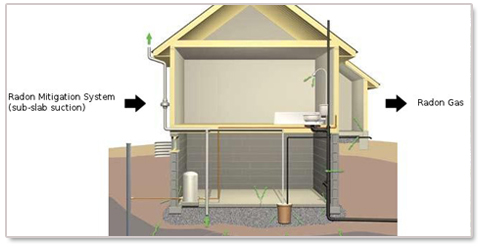What is Radon?
Radon is a colorless, odorless, radioactive gas. It forms  naturally from the decay of uranium that is found in rock, soil, and water. Once it is produced, radon moves from the ground into the air. Some of it remains below the surface and dissolves in the water that flows underground.
naturally from the decay of uranium that is found in rock, soil, and water. Once it is produced, radon moves from the ground into the air. Some of it remains below the surface and dissolves in the water that flows underground.
Radon is the second leading cause of lung cancer, only second to smoking. When it moves up through the ground to the air above, it can get into your home through:
- Cracks in floors
- Cracks in foundation
- Construction joints
- Gaps in floors
- Gaps around pipes
Once it is inside your home, it builds up and becomes trapped. Radon gas decays into radioactive particles that can get into your lungs from the air you breathe. As they keep breaking down, the particles release small bursts of energy which can damage lung tissue and lead to lung cancer. Breathing radon does not cause any of the short-term effects such as shortness of breath, coughing, headaches or fever.
Radon Testing
The Environmental Protection Agency (EPA) recommends that the action level for radon is 4 pCi/L. However, any level of exposure is unsafe. Since there are no warning signs that you have a build-up of radon in your home, testing is the only way to know if you are at risk. Testing is inexpensive and only takes a few minutes.
AmeriServ Radon Mitigation of Iowa does both short-term testing and long-term testing. Short-term testing is the quickest was to detect radon. This is done when the results need to be determined quickly such as in a real estate transaction. The methods of doing this are:
- charcoal canisters
- electret chamber
- continuous monitors
- liquid scintillation
Radon levels change on a day-to-day basis and season to season. By doing long term testing which lasts 90 days or more, you will get a more accurate idea of what the year round average of the radon level is in your home. We use electret detectors or alpha track detectors for long term testing.
The electret detectors have a Teflon disc that is statically charged. When an ion generated from radon decay strikes the Teflon disc, the electrical charge is reduced and in the laboratory, the charge reduction is measured and the radon level calculated.
The alpha track detectors have a plastic film that gets etched by alpha particles that strike it. In the laboratory, the plastic is chemically treated to make the tracks visible then the tracks are counted.
If a level of 4 pCi/L is detected, immediately action needs to be taken to reduce the level. pCi/L means picocuries per liter. The lower the number the better, but any level of radon can be dangerous. If your home if found to have radon, AmeriServe Radon Mitigation of Iowa can help.
Prevent Radon from Entering your Home
When you have had your home tested and need to get the  radon level reduced, AmeriServ Radon Mitigation of Iowa can perform radon mitigation.
radon level reduced, AmeriServ Radon Mitigation of Iowa can perform radon mitigation.
Radon mitigation is the process of removing radon from your home to the outside. A hole is drilled into your foundation or slab, which creates a suction point. then we use a PVC pipe connected through this hole to use as a vent for the radon gas. Then a fan is connected to this system so that the air flows in the right direction.
Lowering high radon levels requires an expert with the technical knowledge and equipment to handle the job. AmeriServ Radon Mitigation of Iowa has the experts that are licensed and certified who can test and reduce the radon in your home. They are professionally trained by the State of Iowa and certified by the Iowa Department of Public Health.
We will test your home again after mitigation to be sure that the radon levels have been reduced. Our services include a 5 year warranty on the mitigation systems.
The risks of living with radon can be high. There is more to know about the risks of radon and cancer than most other cancer-causing substances. We know more about this because these risks are based on studies of cancer in underground miners.
The risk to your health from radon depends on how much radon is in your home and the amount of time you spend in your home. If you have not had your home tested for radon, don’t hesitate. The sooner it gets tested and the sooner the radon level gets reduced, the safer you will be.
Radon can be present in all types of homes. Construction material and the location are all factors that can affect radon levels. If your home tests high for radon, AmeriServ Radon Mitigation of Iowa will perform professional radon mitigation at an affordable rate.
 Our Response to COVID-19
Our Response to COVID-19 
